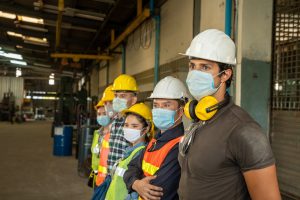Recent federal inspections looking for COVID-19 hazards in the workplace are on the rise in southern states, but have declined in the Northeast and Midwest, according to a Bloomberg Law review of recent Occupational Safety and Health Administration (OSHA) data.
OSHA conducted more inspections in most southern states, including Texas and Louisiana, from May 1 to July 13 than during the same period in 2020, Bloomberg Law reports. Inspections in Texas were up 171%; 57 from May through mid-July 2021, compared to 21 during that same span a year earlier. In Louisiana, inspections rose from seven during that time period in 2020 to 12 a year later, and in Mississippi, the total went from five during that span in 2020 to seven in 2021.
Inspections have gone up in states with low COVID-19 vaccination rates as the dangerous Delta variant is leading to more infections and hospitalizations, according to Bloomberg Law. Another reason for the increase is OSHA’s new National Emphasis Program (NEP) focusing on high-hazard workplaces, which allows the agency to launch an inspection if it believes the business is in a high-risk industry.
COVID-19 inspections have decreased in northeastern states during the May through mid-July period because of fewer complaints and work-related fatalities. OSHA’s NEP focuses on healthcare providers such as hospitals, nursing homes, and clinics, as well as warehouses, grocery stores, postal facilities, and restaurants, Bloomberg Law reports.
The OSHA inspection statistics didn’t include Kentucky, North Carolina, South Carolina, and Tennessee because those states have their own workplace safety agencies. There was no information on whether the inspections led to citations against the employers, Bloomberg Law noted.
OSHA’s National Emphasis Program
In July, OSHA released a directive detailing the NEP, which works “to ensure that employees in high-hazard industries or work tasks are protective from the hazard of contracting SARS-CoV-2 (severe acute respiratory syndrome coronavirus 2), the cause of Coronavirus Disease 2019 (COVID-19). The NEP augments OSHA’s efforts addressing unprogrammed COVID-19-related activities, e.g., complaints, referrals, and severe incident reports, by adding a component to target specific high-hazard industries or activities where this hazard is prevalent.”
The NEP targets businesses that have workers “with increased potential exposure to this hazard, and that puts the largest number of workers at risk,” according to the directive. “In addition, this NEP includes an added focus to ensure that workers are protected from retaliation, and are accomplishing this by preventing retaliation where possible, distributing anti-retaliation information during inspections, and outreach opportunities, as well as promptly referring allegations of retaliation to the Whistleblower Protection Program.”
The NEP’s goal is to continue performing at least 5% of OSHA’s total inspection goal (approximately 1,600 inspections) by focusing on workplace exposures to COVID-19 in certain critical industries. “OSHA anticipates that the majority of the inspections covered under this NEP will continue to occur in general industry, particularly in healthcare, based on current OSHA enforcement data showing higher COVID-19-related complaints, referrals and severe incident reports at healthcare worksites,” according to the directive.

